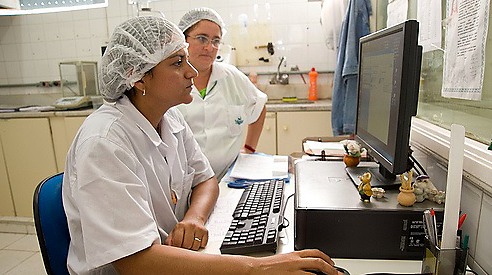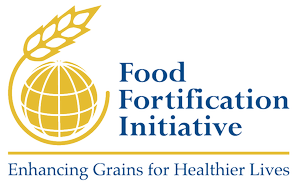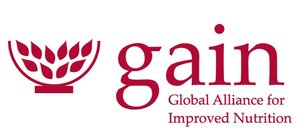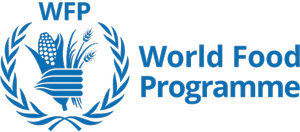Online Fortification Monitoring Courses

Photo: David Snyder for CDC Foundation
This page contains online training courses to teach basic concepts of internal, external, import, and commercial monitoring. It is available for flour fortification and rice fortification. The courses were created in collaboration with Food Fortification Initiative (FFI), the Global Alliance for Improved Nutrition (GAIN), the International Grains Program (IGP) Institute at Kansas State University, and the World Food Programme (WFP). The courses guide participants in planning for a monitoring system; engaging in internal, external, import, and commercial monitoring activities; and collating, reporting, and using monitoring data. Videos, photos, and examples enhance the monitoring concepts. The intended audience of these courses includes representatives of government ministries and partner organizations, flour and rice millers, food inspectors, and laboratory technicians. The courses could be used to guide country leaders who are planning for fortification, to train staff working on fortification programs, or to facilitate a baseline level of knowledge among individuals preparing to attend a fortification workshop.
How to Take the Course
Participants move through the courses at their own pace, reviewing each module and completing the associated quiz before moving to the next module. The modules can be streamed with a stable internet connection. If you are unable to access the modules via streaming and require an offline option, please contact us at info@ffinetwork.org.
Participants need to complete the quizzes that follow each module. Please note: you must watch a module in its entirety prior to taking the quiz. Please retake each quiz until you have answered all questions correctly.
Once you have completed all modules associated with a course and answered all quizzes correctly, please contact info@ffinetwork.org to receive your certificate of completion.
Flour Fortification Monitoring

Module 1 - Introduction
This module introduces the topics of flour production, flour fortification, monitoring, and evaluation. It also highlights some logistical matters related to the course and shows you how to navigate the online course platform.
There is no quiz associated with this module.
Module 2 – Why Fortify
This module explains why fortification is an important public health initiative. It introduces the concept and consequences of vitamin and mineral deficiencies, explains why flour fortification is a feasible and worthwhile public health initiative, and provides evidence for the impact of flour fortification. A personal story is also shared.
Module 3 – Multi-Sector Alliance and Planning for Fortification Monitoring
In this module, the concept of a multi-sector alliance is briefly presented. This group of individuals often leads the planning phase of a flour fortification program.
Module 4 – Planning for Fortification Monitoring
This module guides participants through the key elements of a monitoring plan. Certain elements are highlighted with examples from countries that have mandatory flour fortification programs.
Module 5 – Standards Premix and Laboratories
In this module, three topics that form the foundation of flour fortification monitoring are explained: standards, premix and laboratories. In the first part, fortification standard is defined, and typical specifications of a standard are described. During the premix portion of the module, participants will learn about premix ingredients, choosing a reputable premix company, and pre-blends. During the final part of the module, the qualitative and quantitative tests that are conducted as part of flour fortification monitoring protocols are introduced. The types of laboratories that support flour fortification monitoring efforts and their respective functions are also explained.
Module 6 – Internal Monitoring
This module first introduces the concept of internal monitoring and its two parts: quality assurance (QA) and quality control (QC). Subsequently, detailed explanations of the QA and QC activities are provided.
Module 7 – Regulatory Monitoring Part I: External Monitoring
This module presents regulatory monitoring which encompasses all types of monitoring directed by government regulators. External monitoring, as a type of regulatory monitoring, is explained with a focus on the primary activities: technical audits and factory inspections.
Module 8 – Regulatory Monitoring Part II: Import and Commercial Monitoring
This module continues with the topic of regulatory monitoring, this time focusing on import and commercial monitoring. The procedures that should be followed by inspectors at the border entry points (import monitoring) and at retail locations (commercial monitoring) are detailed. Considerations for interpreting the results of quantitative tests are explained and potential indicators to track are offered.
Module 9 – Quality Management Systems
This module gives a general overview of multiple quality management systems (QMS). It also emphasizes the need to integrate fortification monitoring protocols into the mill’s QMS.
Module 10 – Dealing with Data
This module emphasizes the importance of analyzing, reporting, sharing and using monitoring data. The multi-sector alliance is highlighted again, this time because it plays a vital role in reviewing data findings, making recommendations and ensuring stakeholders follow through with priority changes.
Rice Fortification Monitoring

Module 1 – Introduction
This module introduces the topics of rice production, rice fortification, and monitoring rice fortification programs. It also highlights some logistical matters related to the course.
There is no quiz associated with this module.
Module 2 – Why Fortify
This module explains why fortification is an important public health initiative. It introduces the concept and consequences of vitamin and mineral deficiencies, explains why rice fortification is a feasible and worthwhile public health initiative, and provides evidence for the impact of food fortification programs. A personal story is also shared.
Module 3 – Options for Producing Fortified Rice
This module explains why fortification is an important public health initiative. It introduces the concept and consequences of vitamin and mineral deficiencies, explains why rice fortification is a feasible and worthwhile public health initiative, and provides evidence for the impact of food fortification programs. A personal story is also shared.
Module 4– Multi-Sector Alliance
In this module, the concept of a multi-sector alliance is briefly presented. This group is especially critical for program planning purposes but should remain active after fortification is initiated.
Module 5 - Planning for Fortification Monitoring
This module guides you through the key elements of a monitoring plan. Certain elements are highlighted with examples from countries that have mandatory food fortification programs.
Module 6 – Standards, Fortification Inputs, and Laboratories
This module presents three topics that form the foundation of rice fortification monitoring: standards, fortification inputs, and laboratories. The first part of the module defines a fortification standard and describes typical specifications found in the standard. The second part covers fortification inputs, which include vitamin and mineral blends and fortified kernels for the purpose of this course. In the final section, the qualitative and quantitative tests used for monitoring purposes are introduced. The types of laboratories that support rice fortification monitoring efforts and their respective functions are also explained.
Module 7 – Internal Monitoring
This module first introduces the concept of internal monitoring and its two parts: quality assurance (QA) and quality control (QC). Subsequently, detailed explanations of the QA and QC activities are provided.
Module 8 – Regulatory Monitoring Part I: External Monitoring
This module is the first of two focused on the topic of regulatory monitoring. External monitoring, a component of regulatory monitoring conducted at rice mills, is explained with an emphasis on technical audits and factory inspections.
Module 9 – Regulatory Monitoring Part II: Import and Commercial Monitoring
This module continues with the topic of regulatory monitoring, this time emphasizing import monitoring and commercial monitoring. The procedures that should be followed by border control at land- and water-based entry points (import monitoring) and by inspectors at retail locations (commercial monitoring) are detailed. Potential indicators to track as part of rice fortification monitoring are offered.
Module 10 – Ensuring Product Quality and Safety
This module outlines attributes of management systems that can be utilized by rice mills to promote consistent product quality and safety. It also emphasizes the need to integrate fortification monitoring protocols into any existing management system.
Module 11 – Reporting and Using Data
This module emphasizes the importance of collating, reporting, sharing and using monitoring data. The multi-sector alliance is highlighted again, this time because it plays a vital role in reviewing data findings, making recommendations, and ensuring stakeholders follow through with priority changes.
Final Module: Flour & Rice Fortification Monitoring
Enforcement and Evaluation
The final module in the flour and rice fortification monitoring courses introduces a streamlined approach to enforcement and evaluation for large-scale food fortification. While focused on the current context in Latin American and the Caribbean, the module provides information that may be informative in other regions and countries where fortification is mandatory.
Course Facilitators

Sarah Zimmerman
Sarah Zimmerman is a writer and communications project manager. Her 30-plus years of experience include developing marketing campaigns, remaking websites, and reporting for daily newspapers. When she served as a course facilitator, Sarah was the Communications Coordinator for the Food Fortification Initiative (FFI), a public-private-civic partnership working to improve nutrition via fortified wheat flour, maize flour, and rice. In her role, Sarah collaborated with the FFI staff and international partners to create and disseminate fortification advocacy materials. She wrote and edited journal articles, managed the FFI website and social media, and spoke at advocacy meetings and training events. Sarah earned a bachelor’s degree in journalism from Oklahoma Baptist University and served as a US Peace Corps volunteer in Senegal.

Helena Páchon
Dr. Helena Pachón is a public health nutritionist with over 25 years of work experience in research and programs to address reduce malnutrition particularly in low- and middle-income countries. Currently, she supports food fortification in her capacity as Research Director for the Food Fortification Initiative (FFI). At FFI, Helena collates or generates evidence on the public health impact of wheat flour, maize flour and rice fortification. With her FFI colleagues, she also provides technical assistance to country counterparts in fortification advocacy, monitoring and evaluation. Helena completed her nutrition doctoral training at Cornell University and her Master of Public Health at Harvard University. She has an appointment at Emory University as Research Professor in the Hubert Department of Global Health in the Rollins School of Public Health.

Quentin Johnson
Quentin Johnson has more than 40 years of professional experience in new product development, quality assurance and quality control, food safety, and regulatory affairs related to milling and baking. He has provided technical assistance for the development of wheat and maize flour fortification programs in over 80 countries. Through his own business, Quican Inc., Quentin consults with United Nations’ programs and agencies, donor aid agencies, and international nongovernmental organizations on the topic of staple food fortification. In 2011, Quentin received an Honorary Degree DLL honoris causa from the University of Guelph for his contribution to the advancement of staple food fortification around the world.

Santiago Rodas
Santiago Rodas is a public health nutritionist with over 20 years of experience in research, policy-making, and the design and implementation of programs across government, academia, and the United Nations. He currently serves as Nutrition Program and Policy Officer at the World Food Programme’s (WFP) Regional Office for Latin America and the Caribbean (LAC). In this role, he leads a regional initiative developed in partnership with the Food Fortification Initiative, Emory University, and other academic institutions. The initiative focuses on strengthening enforcement and evaluation systems for large-scale food fortification programs. Santiago also provides technical assistance to WFP country offices and national governments in LAC, supporting the design of nutrition-sensitive social protection programs.




